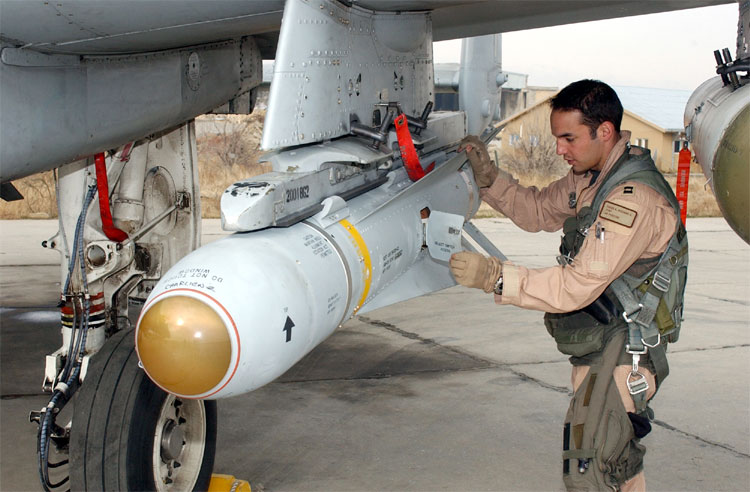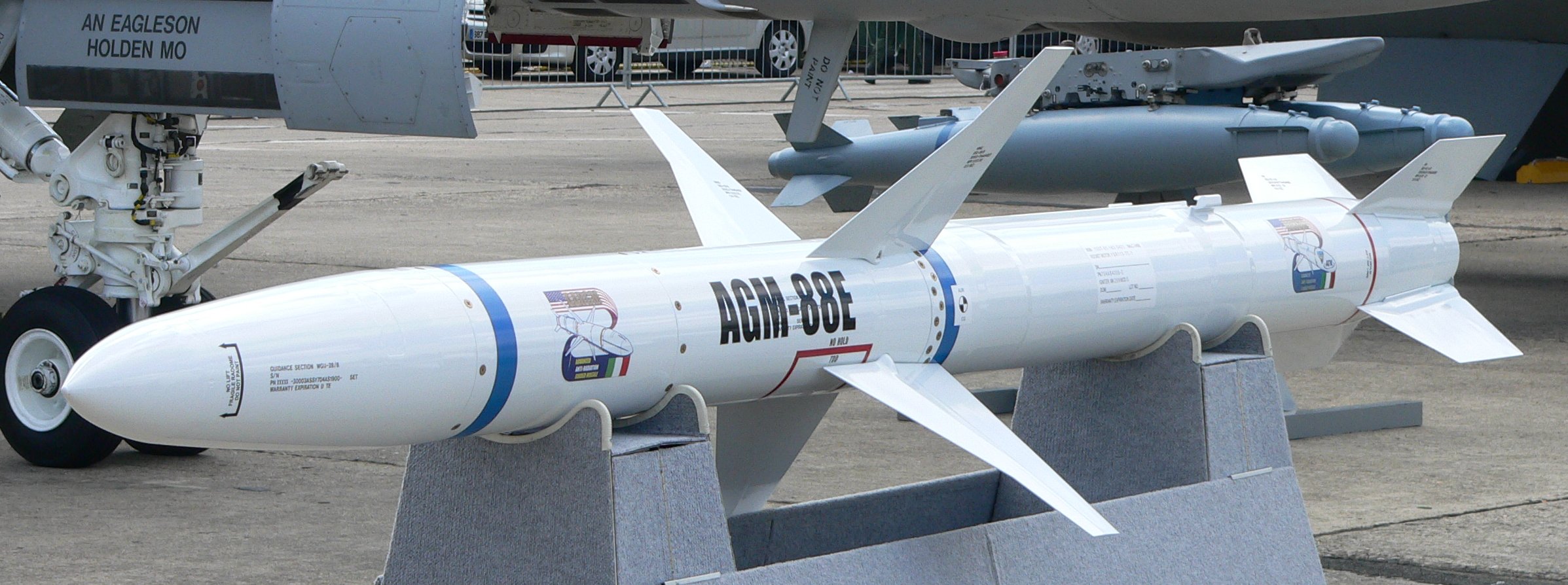|
AGM-122 Sidearm
The AGM-122 Sidearm was an American air-to-surface anti-radar missile produced between 1986 and 1990. While not as capable as newer anti-radiation missiles, they were cheaper and lighter in weight allowing more versatile deployment. Development The AGM-122 Sidearm was produced by the re-manufacture of AIM-9C missiles that had been taken out of service. The AIM-9C was a semi-active radar homing variant of the Sidewinder, developed for the US Navy's Vought F-8 Crusader, but used for only a limited period of time. Conceived and developed at China Lake NAWS, the Sidearm was first tested in 1981. In 1984, Motorola was issued a contract to convert and upgrade AIM-9Cs to the AGM-122A standard. A total of about 700 units were produced between 1986 and 1990. Existing stocks of Sidearm have been depleted, and the missile is no longer in service. Proposals for new-build missiles, under the designation AGM-122B, have not been proceeded with to date. The AGM-122 was less capable than new ... [...More Info...] [...Related Items...] OR: [Wikipedia] [Google] [Baidu] |
|
 |
Air-to-surface
An air-to-surface missile (ASM) or air-to-ground missile (AGM) is a missile designed to be launched from military aircraft at targets on land or sea. There are also unpowered guided glide bombs not considered missiles. The two most common propulsion systems for air-to-surface missiles are rocket motors, usually with shorter range, and slower, longer-range jet engines. Some Soviet-designed air-to-surface missiles are powered by ramjets, giving them both long range and high speed. Guidance for air-to-surface missiles is typically via laser guidance, infrared guidance, optical guidance or via satellite guidance signals. The type of guidance depends on the type of target. Ships, for example, may be detected via passive radar or active radar homing, less effective against multiple, small, fast-moving land targets. There is some cross-over between air-to-surface missiles and surface-to-surface missiles. For example, there was an air-launched version of the Tomahawk missile, super ... [...More Info...] [...Related Items...] OR: [Wikipedia] [Google] [Baidu] |
|
Naval Air Weapons Station China Lake
Naval Air Weapons Station (NAWS) China Lake is a large military installation in California that supports the research, testing and evaluation programs of the United States Navy. It is part of Navy Region Southwest under Commander, Navy Installations Command, and was originally known as Naval Ordnance Test Station (NOTS). The installation is located in the Western Mojave Desert region of California, approximately north of Los Angeles. Occupying land in three counties – Kern, San Bernardino, and Inyo – the installation's closest neighbors are the city of Ridgecrest and the communities of Inyokern, Trona, and Darwin. China Lake is the United States Navy's largest single landholding, representing 85% of the Navy's land for weapons and armaments research, development, acquisition, testing and evaluation (RDAT&E) use and 38% of the Navy's land holdings worldwide. In total, its two ranges and main site cover more than , an area larger than the state of Rhode Island. As of ... [...More Info...] [...Related Items...] OR: [Wikipedia] [Google] [Baidu] |
|
 |
Cold War Air-to-surface Missiles Of The United States
Cold is the presence of low temperature, especially in the atmosphere. In common usage, cold is often a subjective perception. A lower bound to temperature is absolute zero, defined as 0.00K on the Kelvin scale, an absolute thermodynamic temperature scale. This corresponds to on the Celsius scale, on the Fahrenheit scale, and on the Rankine scale. Since temperature relates to the thermal energy held by an object or a sample of matter, which is the kinetic energy of the random motion of the particle constituents of matter, an object will have less thermal energy when it is colder and more when it is hotter. If it were possible to cool a system to absolute zero, all motion of the particles in a sample of matter would cease and they would be at complete rest in the classical sense. The object could be described as having zero thermal energy. Microscopically in the description of quantum mechanics, however, matter still has zero-point energy even at absolute zero, because ... [...More Info...] [...Related Items...] OR: [Wikipedia] [Google] [Baidu] |
 |
Air-to-surface Missiles Of The United States
An air-to-surface missile (ASM) or air-to-ground missile (AGM) is a missile designed to be launched from military aircraft at targets on land or sea. There are also unpowered guided glide bombs not considered missiles. The two most common propulsion systems for air-to-surface missiles are rocket motors, usually with shorter range, and slower, longer-range jet engines. Some Soviet-designed air-to-surface missiles are powered by ramjets, giving them both long range and high speed. Guidance for air-to-surface missiles is typically via laser guidance, infrared guidance, optical guidance or via satellite guidance signals. The type of guidance depends on the type of target. Ships, for example, may be detected via passive radar or active radar homing, less effective against multiple, small, fast-moving land targets. There is some cross-over between air-to-surface missiles and surface-to-surface missiles. For example, there was an air-launched version of the Tomahawk mi ... [...More Info...] [...Related Items...] OR: [Wikipedia] [Google] [Baidu] |
|
AGM-87 Focus
The AGM-87 Focus was an air-to-surface missile developed by the United States. Overview The missile was a development of the AIM-9B Sidewinder air-to-air missile The newest and the oldest member of Rafael's Python family of AAM for comparisons, Python-5 (displayed lower-front) and Shafrir-1 (upper-back) An air-to-air missile (AAM) is a missile fired from an aircraft for the purpose of destroying a ..., intended for use against ground targets. Development took place at the Naval Air Weapons Station China Lake, China Lake Naval Weapons Center during the late 1960s. The infrared homing method of the Sidewinder was retained, as the missile was to be used against targets which emitted an infrared signature. Typical targets included trucks and other such vehicles. The Focus was used in Vietnam during 1969 and 1970, primarily for night attacks when IR emitters stand out well against the cool background. Although the missile was reportedly quite effective, it was discontinued ... [...More Info...] [...Related Items...] OR: [Wikipedia] [Google] [Baidu] |
|
|
Air-to-ground Missile
An air-to-surface missile (ASM) or air-to-ground missile (AGM) is a missile designed to be launched from military aircraft at targets on land or sea. There are also unpowered guided glide bombs not considered missiles. The two most common propulsion systems for air-to-surface missiles are rocket motors, usually with shorter range, and slower, longer-range jet engines. Some Soviet-designed air-to-surface missiles are powered by ramjets, giving them both long range and high speed. Guidance for air-to-surface missiles is typically via laser guidance, infrared guidance, optical guidance or via satellite guidance signals. The type of guidance depends on the type of target. Ships, for example, may be detected via passive radar or active radar homing, less effective against multiple, small, fast-moving land targets. There is some cross-over between air-to-surface missiles and surface-to-surface missiles. For example, there was an air-launched version of the Tomahawk missile, sup ... [...More Info...] [...Related Items...] OR: [Wikipedia] [Google] [Baidu] |
|
 |
Surface-to-air Missile
A surface-to-air missile (SAM), also known as a ground-to-air missile (GTAM) or surface-to-air guided weapon (SAGW), is a missile designed to be launched from the ground to destroy aircraft or other missiles. It is one type of anti-aircraft system; in modern armed forces, missiles have replaced most other forms of dedicated anti-aircraft weapons, with anti-aircraft guns pushed into specialized roles. The first attempt at SAM development took place during World War II, but no operational systems were introduced. Further development in the 1940s and 1950s led to operational systems being introduced by most major forces during the second half of the 1950s. Smaller systems, suitable for close-range work, evolved through the 1960s and 1970s, to modern systems that are man-portable. Shipborne systems followed the evolution of land-based models, starting with long-range weapons and steadily evolving toward smaller designs to provide a layered defence. This evolution of design increasin ... [...More Info...] [...Related Items...] OR: [Wikipedia] [Google] [Baidu] |
 |
Self-propelled Anti-aircraft Weapon
An anti-aircraft vehicle, also known as a self-propelled anti-aircraft gun (SPAAG) or self-propelled air defense system (SPAD), is a mobile vehicle with a dedicated anti-aircraft capability. Specific weapon systems used include machine guns, autocannons, larger guns, or missiles, and some mount both guns and longer-ranged missiles (e.g. the Pantsir-S1). Platforms used include both trucks and heavier combat vehicles such as armored personnel carriers and tanks, which add protection from aircraft, artillery, and small arms fire for front line deployment. Anti-aircraft guns are usually mounted in a quickly-traversing turret with a high rate of elevation, for tracking fast-moving aircraft. They are often in dual or quadruple mounts, allowing a high rate of fire. In addition, most anti-aircraft guns can be used in a direct-fire role against surface targets to great effect. Today, missiles (generally mounted on similar turrets) have largely supplanted anti-aircraft guns, but they ... [...More Info...] [...Related Items...] OR: [Wikipedia] [Google] [Baidu] |
.jpg) |
Fighter Bomber
A fighter-bomber is a fighter aircraft that has been modified, or used primarily, as a light bomber or attack aircraft. It differs from bomber and attack aircraft primarily in its origins, as a fighter that has been adapted into other roles, whereas bombers and attack aircraft are developed specifically for bombing and attack roles. Although still used, the term fighter-bomber has less significance since the introduction of rockets and guided missiles into aerial warfare. Modern aircraft with similar duties are now typically called multirole combat aircraft or strike fighters. Development Prior to World War II, general limitations in available engine and aeronautical technology required that each proposed military aircraft have its design tailored to a specific prescribed role. Engine power grew dramatically during the early period of the war, roughly doubling between 1939 and 1943. The Bristol Blenheim, a typical light bomber of the opening stages of the war, was originally ... [...More Info...] [...Related Items...] OR: [Wikipedia] [Google] [Baidu] |
 |
Fighter Aircraft
Fighter aircraft are fixed-wing aircraft, fixed-wing military aircraft designed primarily for air-to-air combat. In military conflict, the role of fighter aircraft is to establish air supremacy, air superiority of the battlespace. Domination of the airspace above a battlefield permits bombers and attack aircraft to engage in tactical bombing, tactical and strategic bombing of enemy targets. The key performance features of a fighter include not only its firepower but also its high speed and maneuverability relative to the target aircraft. The success or failure of a combatant's efforts to gain air superiority hinges on several factors including the skill of its pilots, the tactical soundness of its doctrine for deploying its fighters, and the numbers and performance of those fighters. Many modern fighter aircraft also have secondary capabilities such as ground-attack aircraft, ground attack and some types, such as fighter-bombers, are designed from the outset for dual roles. ... [...More Info...] [...Related Items...] OR: [Wikipedia] [Google] [Baidu] |
 |
AGM-88 HARM
The AGM-88 HARM (High-speed Anti-Radiation Missile) is a tactical, air-to-surface anti-radiation missile designed to home in on electronic transmissions coming from surface-to-air radar systems. It was originally developed by Texas Instruments as a replacement for the AGM-45 Shrike and AGM-78 Standard ARM system. Production was later taken over by Raytheon Corporation when it purchased the defense production business of Texas Instruments. Description The AGM-88 can detect, attack and destroy a radar antenna or transmitter with minimal aircrew input. The proportional guidance system that homes in on enemy radar emissions has a fixed antenna and seeker head in the missile's nose. A smokeless, solid-propellant, booster-sustainer rocket motor propels the missile at speeds over Mach 2.0. The HARM was a missile program led by the U.S. Navy, and it was first carried by the A-6E, A-7, and F/A-18A/B aircraft, and then it equipped the EA-6B and EA-18G dedicated electronic attack ai ... [...More Info...] [...Related Items...] OR: [Wikipedia] [Google] [Baidu] |